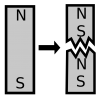The Quest for the One-Sided Magnet
If you cut a magnet in half, you won’t end up with a north piece and a south piece. You’ll end up with two pieces, both of which have a north and a south pole. Even if you cut it down to the size of an atom, the resulting magnet would still be a dipole—having two opposite poles. Why hasn’t a monopole, or a single pole magnet, been discovered yet?
Monopoles have been predicted for many years, but not yet discovered in nature. If found, they could have a bigger impact on modern physics than the Higgs-Boson. So, where can one find this elusive one-sided magnet?
While it has long been predicted by physicists, the monopole has yet to actually be proven to exist. This lack of monopoles is messing with our understanding of the universe. Since magnetism and electricity, together, make up the electromagnetism that governs our universe, it would make sense for them to be symmetrical, right? Unfortunately, this is not the case. Why, if there are single pole electric charges (protons and electrons), aren’t there also single magnetic north and south poles?
Finding Fakes
Back in the 1930s, theoretical physicist Paul Dirac proposed that a magnetic monopole existed in nature. In 2014, a team of scientists from Amherst College in Massachusetts and Aalto University in Finland created an artificial example, over 80 years after it was predicted by Dirac. While this proves that the monopole could exist in the universe, it doesn’t prove if it actually does.
A year after the discovery, another instance was created by the same team in the form of a quantum monopole. While both instances closely resemble the magnetic monopole, each has its differences. The original experiment “simulates the motion of a charged particle in the vicinity of a monopolar magnetic field” while the other has a “point-like structure in its own field resembling that of the magnetic monopole particle itself.”¹
Combining Magnetic Forces
Recently, two phenomena that closely resemble the magnetic monopole have merged to become one phenomenon. It was discovered that within the span of one second, the quantum monopole can transform into the Dirac monopole. The process is explained here:
The scientists start with an extremely dilute gas of rubidium atoms chilled near absolute zero, at which temperature it forms a Bose-Einstein condensate. Subsequently, they prepare the system in a non-magnetized state and ramp an external magnetic-field zero point into the condensate thus creating an isolated quantum monopole. Then they hold the zero point still and wait for the system to gradually magnetize along the spatially varying magnetic field.²
It is not yet clear what this discovery means for the hunt for the real magnetic monopole. If these two artificial monopole instances can occur, why haven’t we located one in nature yet? With this discovery, scientists are one step closer to making a discovery that could open up a new door for the scientific world.
For more magnet-related news, head to our News & How-Tos section, and make sure to check out our online catalog of products for all of your magnetic needs.

